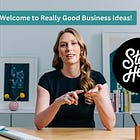The Subtle Skill of Having Strong Opinions (Without Being Stubborn)
Why conviction matters and how to keep it from turning into rigidity.
Having a point of view is one of the most underrated skills in business. The people who rise fastest tend to have opinions; clear, confident takes about what’s important and how decisions should be made.
But there’s a catch: if you hold those opinions too tightly, you stop learning. You become a liability to your own ideas, missing crucial feedback that would make them better. You mistake conviction for correctness.
This is why, at Shopify, we had a foundational value that cut through that fog: “Strong opinions, loosely held.” This simple phrase contains a surprisingly hard balance. It’s about having enough belief to move things forward, but remaining detached enough to change course when the data proves you wrong.
This value was so core that we wouldn’t hire someone without a point of view. I remember sitting in a recap for a CMO candidate who, on paper, was perfect: experienced, thoughtful, collaborative. But throughout the interviews, they never once shared a clear opinion on Shopify’s growth. Instead, they’d cleverly mirror what each interviewer said, stitching together insights and repeating them back in later conversations.
It was smart, but it revealed something deeper: they were gathering information, not forming a perspective. And that was the difference. We weren’t looking for someone who could absorb our thinking. We wanted someone who could add to it.
Why Having a Strong Point of View Is Important
Having a point of view isn’t about being right; it’s about being willing to start the conversation.
In any environment, whether it’s a 10,000-person company or a one-person business, indecision is the silent killer. Teams stall, projects drift, and opportunities die in the gray zone of “Let’s think about it more.” A strong point of view cuts through that fog.
When you have a clear opinion (even a provisional one), you create movement. You give your team, customers, or collaborators something to react to. It changes the situation from “What do we think about this?” to “Here’s my take, what am I missing?” That’s how momentum starts. Think of a point of view as a compass, not a cage.
At Shopify, the people who thrived weren’t the ones who waited for consensus. They were the ones who had a take. They could articulate a direction, explain the why, and invite challenge. It made collaboration faster and more meaningful because the work became about testing ideas, not tiptoeing around them.
The same is true when you’re building your own business. If you don’t stand for something, your brand disappears into the noise. Having a point of view helps customers understand what makes you different, and enables you to make decisions faster because you’re not starting from a blank slate every time.
A point of view is ultimately a form of leadership. It says: I’ve thought about this, I care enough to take a stance, and I’m open to being proven wrong. The true measure of a leader isn’t being right all the time, but the willingness to engage. Your take evolving is proof of your engagement, and that’s what matters most.
How to Form a Point of View

Here’s the problem: everyone tells you to “have a POV,” but almost no one explains how to build one. It’s treated like something you either have or don’t, when in reality, it’s a muscle you develop through deliberate practice. The more you do it, the easier it gets.
A strong point of view is rooted in three key elements: input, interpretation, and articulation.
Start With High-Quality Inputs. You can’t form an original opinion from low-quality information. Read widely outside your niche, not just within it. Talk to customers. Watch what competitors ignore. The goal isn’t to absorb consensus, it’s to notice the edges where consensus breaks down.
Connect the Dots. A POV is rarely born from one data point. It comes from seeing patterns: spotting where trends collide or where something doesn’t quite fit. Keep a running log of your thoughts and ideas. Patterns emerge faster when you track them over time.
Force Yourself to Articulate It. Thinking isn’t real until you write or say it. Start small: post a take, sketch a framework, explain your reasoning to a friend. Once it’s visible, you’ll immediately see what’s fuzzy or shallow. That’s how you sharpen your POV and get to the root of the issue.
Pressure-Test It With Dissent. Share your thoughts with people who don’t agree. Ask “What am I missing?” The goal isn’t to defend your take; it’s to see if it holds up under friction, which makes your POV stronger.
Iterate Publicly. You don’t need to have everything figured out to share it. The best thinkers update their views in public. That transparency, showing your reasoning as it evolves, builds credibility faster than pretending you’re certain.
Here’s the thing: you’ll get it wrong sometimes. But in business, it's better to be wrong (and course-correct) than to form no opinion at all.
A point of view isn’t a single statement; it’s a process of ongoing sense-making. The more you expose yourself to new information, synthesize patterns, and communicate your thinking, the stronger (and more flexible) your POV becomes.
Where Strong Opinions Go Wrong

Conviction is powerful, but it’s a double-edged sword. The same force that moves things forward can just as easily shut them down.
Strong opinions become a problem when they stop evolving. When confidence turns into certainty, and certainty hardens into ego, you stop seeing clearly. Instead of testing ideas, you start defending them. Instead of seeking truth, you start seeking to win.
In business, this usually shows up in two ways:
Attachment to being right. You identify so closely with your ideas that feedback feels personal. You stop listening, even when the data (or your team) is telling you something’s off.
Attachment to the past. You assume that what worked before will always work again. But markets, audiences, and algorithms change, and clinging to old assumptions quietly kills innovation.
As a founder, this trap is especially dangerous. Your vision is what sets you apart, but it can also blind you to new information. The businesses that stay relevant aren’t led by people who are always right. They’re led by people who are willing to update their beliefs fast.
Strong opinions aren’t the problem. Stale ones are.
How to Hold Opinions Loosely

The goal isn’t to have fewer opinions, it’s to hold them better.
“Strong opinions, loosely held” isn’t just a catchy phrase; it’s a mindset shift. It means being confident enough to take a stance and humble enough to change it. That combination of conviction plus flexibility is what separates good thinkers from great ones.
Here’s how to practice it in the real world:
Treat Your Opinions Like Hypotheses. Start with a belief, but phrase it as a test: “I think this will work because…” That small shift invites experimentation instead of defensiveness.
Seek Disconfirming Evidence. Ask questions that could prove you wrong. The faster you surface counterexamples or opposing data, the stronger your eventual conclusions become.
Detach Your Ego From Your Ideas. The more your identity is tied to being right, the harder it is to adapt. Detach self-worth from correctness. Your value comes from learning, not just from knowing.
Build Feedback Loops You Actually Trust. Whether that’s data, teammates, or customers, design systems that keep you honest. If you build them publicly, feedback will come in real-time. Listen for patterns.
Move Fast, Then Revise. Momentum doesn’t come from being certain; it comes from being willing to decide, test, and update. Shipping imperfect ideas is often the only way to refine them.
When you hold your opinions loosely, you don’t lose strength; you gain agility. You still move decisively, but you can pivot when the world changes around you. That’s what makes this such a superpower for leaders, founders, and creators alike: you’re not attached to always being right, just to getting it righter over time.
A strong POV gives you direction; holding it loosely gives you adaptability. You form it through curiosity, sharpen it through articulation, and strengthen it through feedback.
If you can learn to believe deeply while staying open to being wrong, you become unstoppable. You’ll make faster decisions, build more resilient businesses, and create cultures where learning moves at the speed of action.
To endless possibilities,
Casandra






